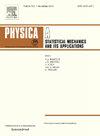基于改进SIR传染病模型的延迟传播分析
IF 2.8
3区 物理与天体物理
Q2 PHYSICS, MULTIDISCIPLINARY
Physica A: Statistical Mechanics and its Applications
Pub Date : 2025-06-02
DOI:10.1016/j.physa.2025.130746
引用次数: 0
摘要
为了研究飞机运行飞行阶段延误的传播机制,提出了一种改进的基于易感感染恢复(SIR)模型的延误传播分析方法。首先,利用航段所经过航班的延误信息计算航段间的相关性,确定航段间延误传播的概率;然后,模拟空中交通管制员在延误发生后所做的调整,根据飞行阶段延误缓解程度与飞行时长的关系,动态调整恢复率,从而改进SIR模型。在此基础上,利用延迟传播网络和改进SIR模型对航段间的延迟传播进行了分析。分析不同航段的延误对整个空中交通的影响,确定关键航段。最后,利用该方法评估航段的重要性,发现对延误产生和传播有重大影响的航段。基于2022年1月1日至2022年5月31日中南区域航线网络实际运行数据的仿真实验,确定了HOK-LKO、AKUBA-LUMKO、ligi - opuni等12个航段相对于其他航段具有显著重要性。通过对比传统节点重要性评价算法、现有传染病模型和改进传染病模型的结果,发现改进传染病模型能更好地识别出对航线网络稳定性和连通性贡献更大的航段,以及整个空中交通网络结构中不同航段的重要性差异。该方法可以有效地提高对延迟传播的理解和控制。本文章由计算机程序翻译,如有差异,请以英文原文为准。
Delay propagation analysis based on an improved SIR infectious disease model
To investigate the propagation mechanism of delays during the flight phase of aircraft operations, this paper proposes an improved Susceptible-Infected-Recovered (SIR) model-based method for delay propagation analysis. Firstly, the correlation between flight segments is calculated using the delay information of the flights that the segments pass through to determine the probability of delay propagation between segments. Then, the adjustments made by air traffic controllers after the occurrence of delays are simulated, and the recovery rate is dynamically adjusted based on the relationship between the delay mitigation level during the flight phase and flight duration, thereby improving the SIR model. On this basis, an analysis of the delay propagation between flight segments is conducted using the delay propagation network and the improved SIR model. The impact of delays in different segments on the entire air traffic is analyzed to identify key segments. Finally, this method is used to evaluate the importance of flight segments and to discover segments that have a significant impact on the generation and propagation of delays. A simulation experiment based on the actual operational data of the Central and Southern regional route network from January 1, 2022, to May 31, 2022, identified 12 flight segments, including HOK-LKO, AKUBA-LUMKO, LIG-OPUNI,among others,as significantly important compared to other segments. By comparing the results between traditional node importance evaluation algorithms, the current infectious disease model, and the improved infectious disease model, it was found that the improved infectious disease model can better identify segments that contribute more to the stability and connectivity of the route network, and the differences in importance of different segments within the entire air traffic network structure. This method is effective in improving the understanding and control of delay propagation.
求助全文
通过发布文献求助,成功后即可免费获取论文全文。
去求助
来源期刊
CiteScore
7.20
自引率
9.10%
发文量
852
审稿时长
6.6 months
期刊介绍:
Physica A: Statistical Mechanics and its Applications
Recognized by the European Physical Society
Physica A publishes research in the field of statistical mechanics and its applications.
Statistical mechanics sets out to explain the behaviour of macroscopic systems by studying the statistical properties of their microscopic constituents.
Applications of the techniques of statistical mechanics are widespread, and include: applications to physical systems such as solids, liquids and gases; applications to chemical and biological systems (colloids, interfaces, complex fluids, polymers and biopolymers, cell physics); and other interdisciplinary applications to for instance biological, economical and sociological systems.

 求助内容:
求助内容: 应助结果提醒方式:
应助结果提醒方式:


